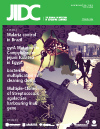Validation of a particle gel immunoassay for Trypanosoma cruzi antibody detection using plasma samples collected with capillary tubes
DOI:
https://doi.org/10.3855/jidc.784Keywords:
Chagas disease, Diagnosis, Particle gel immunoassay, Capillary tubeAbstract
Introduction: The Chagas disease particle gel immunoassay (PaGIA-Chagas) is a simple, fast and practical test used for the diagnosis of the chronic Chagas disease and is based on anti-Trypanosoma cruzi antibody detection in serum. This study aimed to validate the PaGIA-Chagas on plasma collected with capillary tubes.
Methodology: Serum samples from 74 T. cruzi-infected and 26 non-infected individuals were tested by conventional indirect immunofluorescence and PaGIA-Chagas. Later, plasma specimens collected with capillary tubes from these same individuals were tested by PaGIA-Chagas. Results from serum samples tested by IFA and PAGIA- Chagaswere considered as the reference standard to determine the accuracy parameters of the particle gel tested on plasma samples. The inter-test agreement of T. cruzi antibody detection by PaGIA-Chagas on serum and plasma was calculated using Kappa index.
Results: The PaGIA-Chagasperformed on plasma collected with capillary tubes had sensitivity and specificity of 99% and 100%, respectively. The crude agreement observed with the results of the PaGIA-Chagas on plasma and serum was 99% and the Kappa index was 0.975 (CI95%: 0.782 - 1.000).
Conclusion: PaGIA-Chagas for anti-T. cruzi detection on plasma collected with capillary tubes is accurate and might be indicated to reduce fieldwork time and materials in epidemiological screening of chronic Chagas disease.
Downloads
Published
How to Cite
Issue
Section
License
Authors who publish with this journal agree to the following terms:
- Authors retain copyright and grant the journal right of first publication with the work simultaneously licensed under a Creative Commons Attribution License that allows others to share the work with an acknowledgement of the work's authorship and initial publication in this journal.
- Authors are able to enter into separate, additional contractual arrangements for the non-exclusive distribution of the journal's published version of the work (e.g., post it to an institutional repository or publish it in a book), with an acknowledgement of its initial publication in this journal.
- Authors are permitted and encouraged to post their work online (e.g., in institutional repositories or on their website) prior to and during the submission process, as it can lead to productive exchanges, as well as earlier and greater citation of published work (See The Effect of Open Access).








